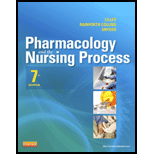
To discuss:
The pathophysiology of vomiting and nausea including its specific precipitating factors and/or diseases.
Concept introduction:
Vomiting and nausea are the two gastrointestinal disorders. The unpleasant feeling that leads an urge in vomiting is called nausea. The forcible expulsion or emptying of intestinal contents through the mouth is called emesis or vomiting. A variety of stimuli are involved in triggering the feeling of nausea and vomiting are unpleasant sights, foul smell or taste, stomach or intestinal irritation, and the use of certain drugs.
Explanation of Solution
Vomiting center is responsible for the initiation of vomiting and nausea. Vomiting center is the area of the brain that is involved in the stimulation of nausea and vomiting. The chemoreceptor trigger zone (CTZ) is another area of the brain, which is also involved in the induction of vomiting and nausea. It sends neurotransmitter signals to the vomiting center about the presence of nauseating substances in the body. These signals alert the brain to expel the nauseating substances out from the body. The vomiting reflex will be initiated with the stimulation of CTZ and the vomiting center.
The neurotransmitters that are involved in the vomiting pathway includes acetylcholine (ACh), dopamine (D2), histamine (H1), prostaglandins, serotonin (5-HT3), and substance P (Neurokinin 1).
The various areas or pathways that are involved in sending signals to the vomiting center in the brain are gastrointestinal tract, cerebral cortex, and labyrinth (inner ear).
The symptoms of vomiting could occur due to various factors such as stress, illnesses, and certain medications. Apart from this, two specific types of factors are also involved, such as post-operative and chemotherapy-induced nausea and vomiting.
The pathophysiology of nausea and vomiting, including its specific factors is discussed.
Want to see more full solutions like this?
- 63. 64. 65. Rhythm: P wave: QRS Complex: Rate: PRI: Interpretation: Rhythm: P wave: QRS Complex: 66. 67. 68. Rhythm: P wave: QRS Complex: Rhythm: P wave: QRS Complex: Rate: PRI: Interpretation: Rate: PRI: Interpretation: Rate: PRI: Interpretation:arrow_forward59. 57. 60. 62. 55. سلسلہ ་་་་arrow_forward• Define the first stage of labour. • Describe the physiology of the first stage of labour. • Enumerate any four (4) potential complications during puerperium and highlight key measures to manage these complications.arrow_forward
- • Define obstetric emergencies and state and briefly explain any two (2) maternal, foetal, and obstetric complications that require immediate intervention. • Explain how mental health services can be effectively integrated into maternal and child health, viz-a-viz early childhood development. • Enumerate any four (4) foetal malpresentations in pregnancy and briefly explain their implication in labour while also highlighting their causes and possible complications.arrow_forward• Briefly highlight the physiological changes in pregnancy in relation to cardiovascular and endocrine systems, as well as the uterus and the skin. • Discuss the current antenatal care approach for pregnant women and provide the highlight of activities conducted during woman’s antenatal visit, clearly describing the steps needed for successful antenatal care. • Enumerate any three (3) abnormalities related to placental development and their implications to pregnancy or childbirth.arrow_forward58 64. Rhythm: Clues: Rhythm: Clues: 62 Rhythm QRS Complex Rates PRI Interpretation Rhythm: P wave QRS Complex Rate PRI Interpretation Rhythm: Clues: Rhythm P wave: QRS Complex Rate PRI Interpretation: Rhythm: P wave: QRS Complex: Rate: Interpretation: 67 Rhythm: P wave: QRS Complex: Rate: PRI Interpretation: Rhythm: P wave: QRS Complex: Rate: PRI Interpretation: 68 Rhythm P waves QRS Complex Rate PRI Interpretation Rhythm P wave QRS Complex Rhythm: P wave QRS Complex: Rate PRI Interpretations Rate PRI Interpretationarrow_forward
- 51. 52. 53. Rhythm: Clues: Rhythm: Clues: Rhythm: Clues:arrow_forwardRegularity- Rate- P waves- PRI- QRS- Interpretation- atrial dysrthmia,junctional dysrthymia,and ventricular rhythm,heart blocks,normal sinus,PVCarrow_forwardnormal sinus,atrial dysrthmia,junctional dysrthymia,and ventricular rhythm,heart blocks,PVCarrow_forward
- normal sinus,atrial dysrthmia,junctional dysrthymia,and ventricular rhythm,heart blocksarrow_forwardA 40-year-old male farmer was rushed to an ER with complaints of fever, abdominal pain/tenderness, nausea and vomiting. Clinical examination and investigations revealed diagnosis of typhoid perforation and he was booked for exploratory laparotomy. Explain in detail the pre - operative care of this patient.arrow_forwardAs a nursing student wanting to do preceptorship at ICU or ER, answer the following question: Why are you requesting this site? How will this unit meet your learning needs?How will this unit contribute to your professional goals?arrow_forward
 Phlebotomy EssentialsNursingISBN:9781451194524Author:Ruth McCall, Cathee M. Tankersley MT(ASCP)Publisher:JONES+BARTLETT PUBLISHERS, INC.
Phlebotomy EssentialsNursingISBN:9781451194524Author:Ruth McCall, Cathee M. Tankersley MT(ASCP)Publisher:JONES+BARTLETT PUBLISHERS, INC. Gould's Pathophysiology for the Health Profession...NursingISBN:9780323414425Author:Robert J Hubert BSPublisher:Saunders
Gould's Pathophysiology for the Health Profession...NursingISBN:9780323414425Author:Robert J Hubert BSPublisher:Saunders Fundamentals Of NursingNursingISBN:9781496362179Author:Taylor, Carol (carol R.), LYNN, Pamela (pamela Barbara), Bartlett, Jennifer L.Publisher:Wolters Kluwer,
Fundamentals Of NursingNursingISBN:9781496362179Author:Taylor, Carol (carol R.), LYNN, Pamela (pamela Barbara), Bartlett, Jennifer L.Publisher:Wolters Kluwer, Fundamentals of Nursing, 9eNursingISBN:9780323327404Author:Patricia A. Potter RN MSN PhD FAAN, Anne Griffin Perry RN EdD FAAN, Patricia Stockert RN BSN MS PhD, Amy Hall RN BSN MS PhD CNEPublisher:Elsevier Science
Fundamentals of Nursing, 9eNursingISBN:9780323327404Author:Patricia A. Potter RN MSN PhD FAAN, Anne Griffin Perry RN EdD FAAN, Patricia Stockert RN BSN MS PhD, Amy Hall RN BSN MS PhD CNEPublisher:Elsevier Science Study Guide for Gould's Pathophysiology for the H...NursingISBN:9780323414142Author:Hubert BS, Robert J; VanMeter PhD, Karin C.Publisher:Saunders
Study Guide for Gould's Pathophysiology for the H...NursingISBN:9780323414142Author:Hubert BS, Robert J; VanMeter PhD, Karin C.Publisher:Saunders Issues and Ethics in the Helping Professions (Min...NursingISBN:9781337406291Author:Gerald Corey, Marianne Schneider Corey, Cindy CoreyPublisher:Cengage Learning
Issues and Ethics in the Helping Professions (Min...NursingISBN:9781337406291Author:Gerald Corey, Marianne Schneider Corey, Cindy CoreyPublisher:Cengage Learning





